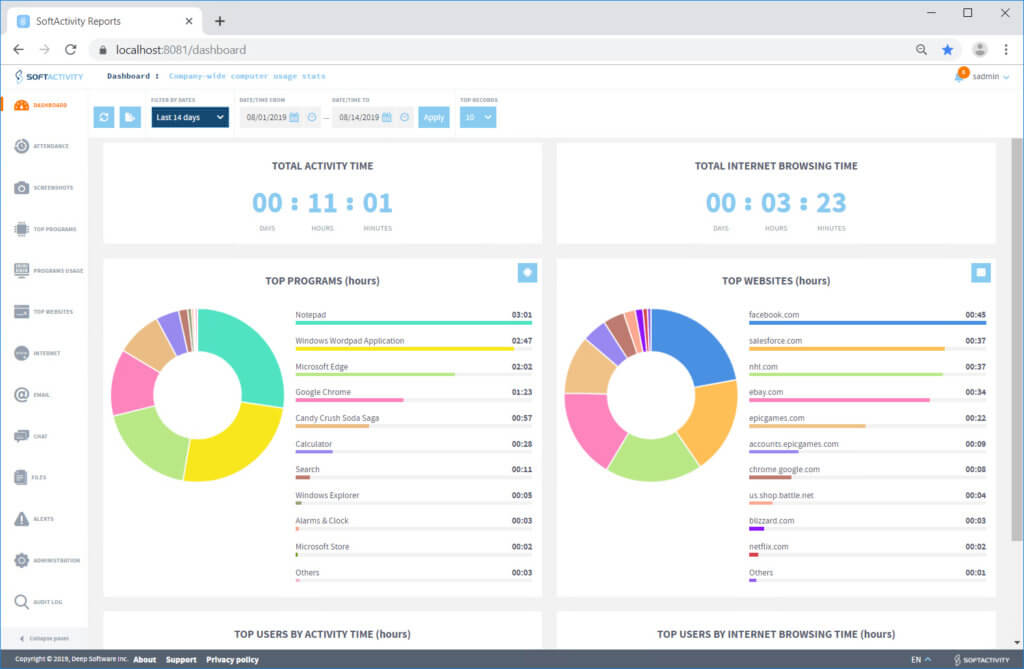How Do You Evaluate a Remote Employee?
Businesses usually conduct employee evaluations on an annual basis to review how well an employee is doing, their work duties and habits, and compare what the employee did against what was expected of them.
An employee performance evaluation is an extremely useful tool that businesses use to gauge time theft, work expectations, raises, promotions, and bonuses.
However, if you operate a remote workforce, you might find that evaluating your remote employees is easier said than done. It is different from the way in-person office personnel can assess their employees.
To help new remote managers handle this challenge, we’ve documented the best way to evaluate a remote employee:

Challenges When it Comes to Evaluating Remote Work
Businesses that hire remote employees expect to offset some of the drawbacks with some of the positives. For example, remote workforces can take advantage of hiring employees from around the world, tapping into previously unprecedented talent pools. As a trade-off, these businesses might experience competition from freelance or contract-work competitors and might have to offer competitive salaries.
Whether you have a contract, freelance, or remote salaried individual, you need to keep track of employee productivity, successes, and failures to review their role in your company. Unfortunately, managing remote employees can be challenging.
For salaried individuals, businesses generally have more control over remote employee tracking. Many companies will be able to send a work-controlled laptop to that employee.
You might hold regular meetings with your remote employees. Even if these meetings are held virtually, they can still be a useful gauge of when your employees are working, how prepared they are for work, and how successful they are in their daily tasks.
The biggest challenge, of course, is remotely monitoring time and projects. If you don’t have an employee monitoring software in place, and one that is tracking the amount of time spent on a project, on a given app or website, or monitoring to ensure that your remote employee is working, then you have no way of confirming that your employees are working when they say they are and fulfilling (or exceeding) the job expectations.
When it comes to job performance, your employees might be:
- Pretending to work when they are only clocking in for attendance
- Not showing up for work and then complaining about job environment or expectations (like your business’ workflow is the problem)
- Shifting their work onto other employees, as they can take advantage of the fact that everyone is spread out and not in constant communication with each other
- Taking far less time on a project that should take longer
- Working on their phone or in a weird setting so that they can’t concentrate on their work
- Experiencing bouts of their internet being down when they are lying
- Watching Netflix or Youtube when they should be working on a project
Most of these challenges can be mitigated with the proper tools, oversight, and levels of accountability.
5 Tips for Evaluating a Remote Employee
Remote worker evaluations are based on a decent amount of preparation. Consider these 5 tips to be prepared for remote work evals:
1) Hold Regular Virtual Meetings to Measure Remote Employee Performance

Performance can be hard to measure in remote workforces because managers don’t physically see employees. So, in addition to not knowing what they do in the day-to-day, managers have no real sense of how often or how hard an employee is working and the small things they do to improve the work quality.
Holding regular virtual meetings one-on-one or with your team can set that expectation earlier. Managers can use these meetings to talk about employee progress around specific tasks or projects, their views or frustrations on the job, and other workplace issues. This could improve the employee experience and employee satisfaction in your company culture.
If a remote team member is regularly coming to a meeting unprepared, late, or with their projects unfinished, then this could be used as a measure of performance.
2) Identify and Confirm the Key Performance Indicators (KPIs) for Each Job Title Upon Hiring
It’s important that however you decide to measure performance, it is established early on in the employee’s tenure and preferably in the onboarding process. If they learned two years into a job that the quality of their online presentation would be used in their annual performance review, they might be frustrated. In this type of instance, they would want to know ahead of time what it takes to perform well. By knowing this information, as well, they better understand their job role and job expectations.
Provide examples of what is important and what is included in remote performance reviews. You can even provide a sample employee evaluation early on so that they can study it and prepare. This isn’t cheating (especially since some of these performance indicators cannot be fudged), but it gives them a chance to perform exceptionally well for your business.
3) Implementing Performance Measurement Software
You’ll need something objective to measure the performance of your remote employees.

Implement a performance measurement software, like remote employee monitoring software, to gain performance metrics around time tracking, attendance, project and task performance and progress, accountability, wasted time, and even verify when employees are working.
Employee monitoring software is software that helps businesses track employee productivity and security. So, your business is completely right in adopting this type of software. Whether your employees agree with it or not, it is not up to them. As the employer, you can set the standard in your remote work policy that to work for your company, remote employees have to download the software and use it regularly.
4) Hold Quarterly Meetings With Remote Employees to Discuss Performance
Checking in with your remote employees regularly will help them understand how they are doing in the broader context of your business. Hold meetings with them every quarter so that they are familiar with this process. If you hold regular quarterly meetings, you can check up the things that are important to you (like a certain number of tasks being completed monthly or time spent taking breaks) and then make sure that your employees get back on track.
You want your employees to succeed (remember: high turnover rates are bad!), giving them this chance to redeem themselves and correct poor behavior.
5) Set Clear Performance Indicators Based on Team Accountability
It can be hard to keep up with employee performance when managers or PMs are also looking at team performance, project success, and other internal KPIs. If you have a team of employees, bring them together and get them all on the same page. Address them and tell them it’s okay to have frustrations about work and express them with colleagues.
You can set aside time where your team meets to discuss these frustrations. You may find that your employees like to complain; if so, they will still feel appreciated and that the company does not want them to be frustrated, and they also want to hear complaints.
Additionally, if multiple employees are being held back by certain barriers, then your company can do something about that! Use team accountability sessions to stop poor behavior, improve toxic work processes, and improve job performance.
Tools for Measuring Remote Job Performance
With the rise of remote workforces across the globe, either due to the COVID-19 pandemic or the rise in capable technologies, we see many businesses unsure of how to handle remote work. Security concerns are increased because of weak personal network security and a lack of enterprise security on personal computers. Additionally, employees must spend time adjusting to the new balance of working from home.
There is a range of ways that businesses can conduct a remote performance review. It’s important to figure out which system works for your business and then set up measurements for determining successes or challenges.
The two most important tools for measuring job performance are remote employee monitoring software and remote productivity software:
Remote Employee Monitoring Software
Monitoring software is a program that is downloaded onto a company and monitors the activity on that computer. This software monitors employee activity and the following:
- Applications and websites opened
- Time spent on applications and websites
- Wasted time reports
- Time tracking for projects and tasks
- Time spent on breaks, overtime, and weekend hours
- Idle time even when time tracking
- Keystroke logging to monitoring communication tools (and to verify that your employees are working and not chatting during work hours)
- Webcam monitoring to make sure your employees are working
- Computer screen monitoring to check that employees are time tracking appropriately
Remote employee monitoring software, like SoftActivity, can be deployed from a single computer console and downloaded onto computers on the network. It can also be downloaded by the user themselves. In remote work, managers will have to ask that each remote worker download the software and configure it with certain settings or sign in to the company’s account.
With this data, PMs and managers can review the time spent on each task daily and observe their employee performance.
Remote Productivity Software
Remote productivity software creates areas or realms where companies can organize their tasks, projects, assignees, due dates, and project progress. These programs provide a high level of organization. They also allow projects to be visualized so that the project is kept on track and that employees understand what they are expected to do and when the project should be completed.
A project manager usually has to configure the software, making sense for the team, and then follow up on the project to make sure it stays on track.
This type of software is essentially for stratified and disjointed remote teams. They can also provide statistics so that PMs and managers see how effectively a project or task was completed based on the assignee or Team Lead.
Implementing Remote Employee Monitoring for Employee Evaluations and Job Performance
Performance is a significant concern for remote working environments. If you have a low producing employee, it can be difficult to evaluate that employee when no software or measurement tools are in place.
Low worker productivity can be a high risk for business security (although this is not a fact, nor cause and effect). Moreover, productivity, and therefore performance, limitations might be happening more since remote employees have to manage more technical issues to do their daily tasks.
When it comes to productivity and performance, remote managers should ensure that there are measures to help employees succeed. Consider:
- A productivity management software that tracks task progress and project milestones
- Clear communications software for communicating deadlines, feedback, or challenges
- Time tracking software for clear task and project management
- Establishing processes, systems, and stakeholders for project completion
By setting up a clear work-from-home productivity policy and process, your remote employees will better understand what is expected of them.
—
By SoftActivity Team